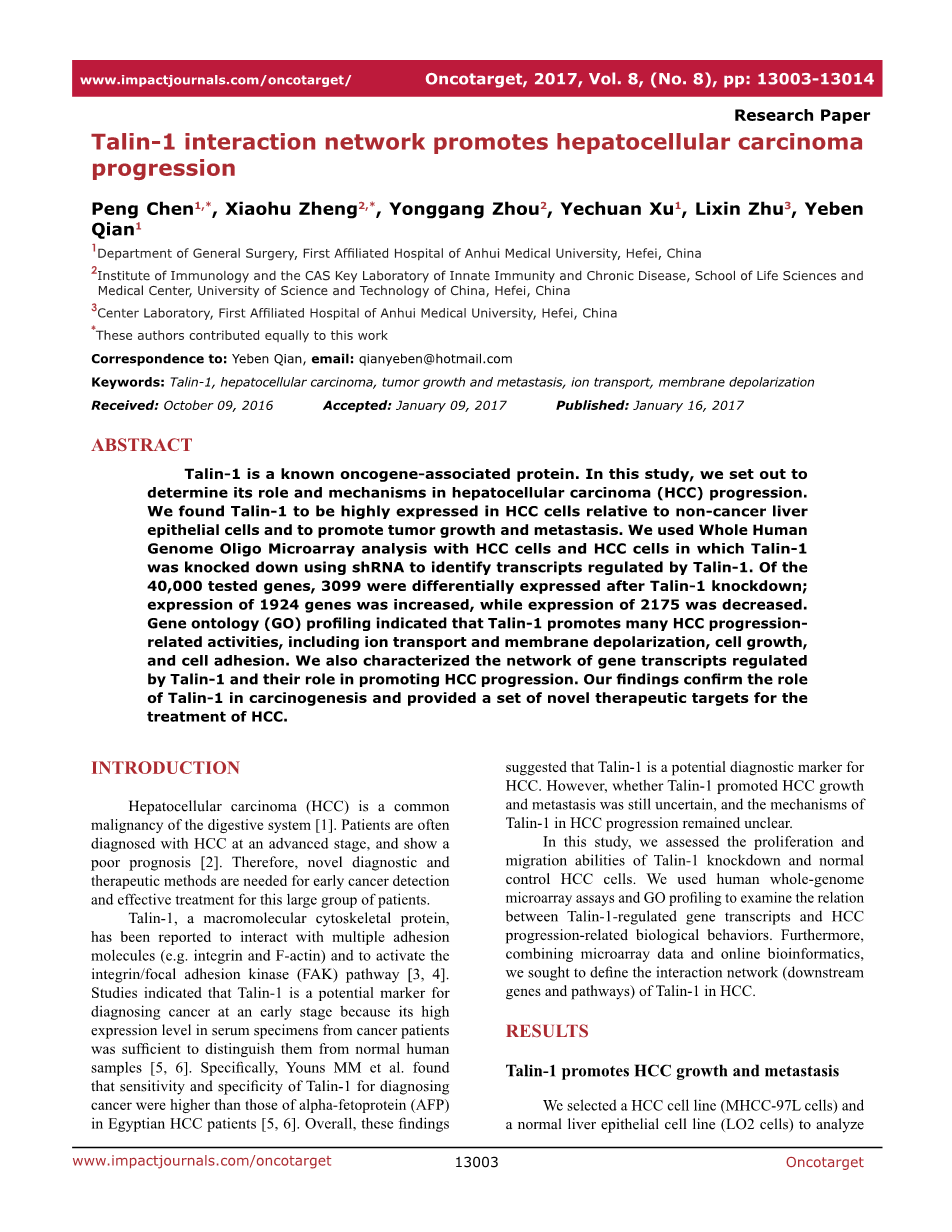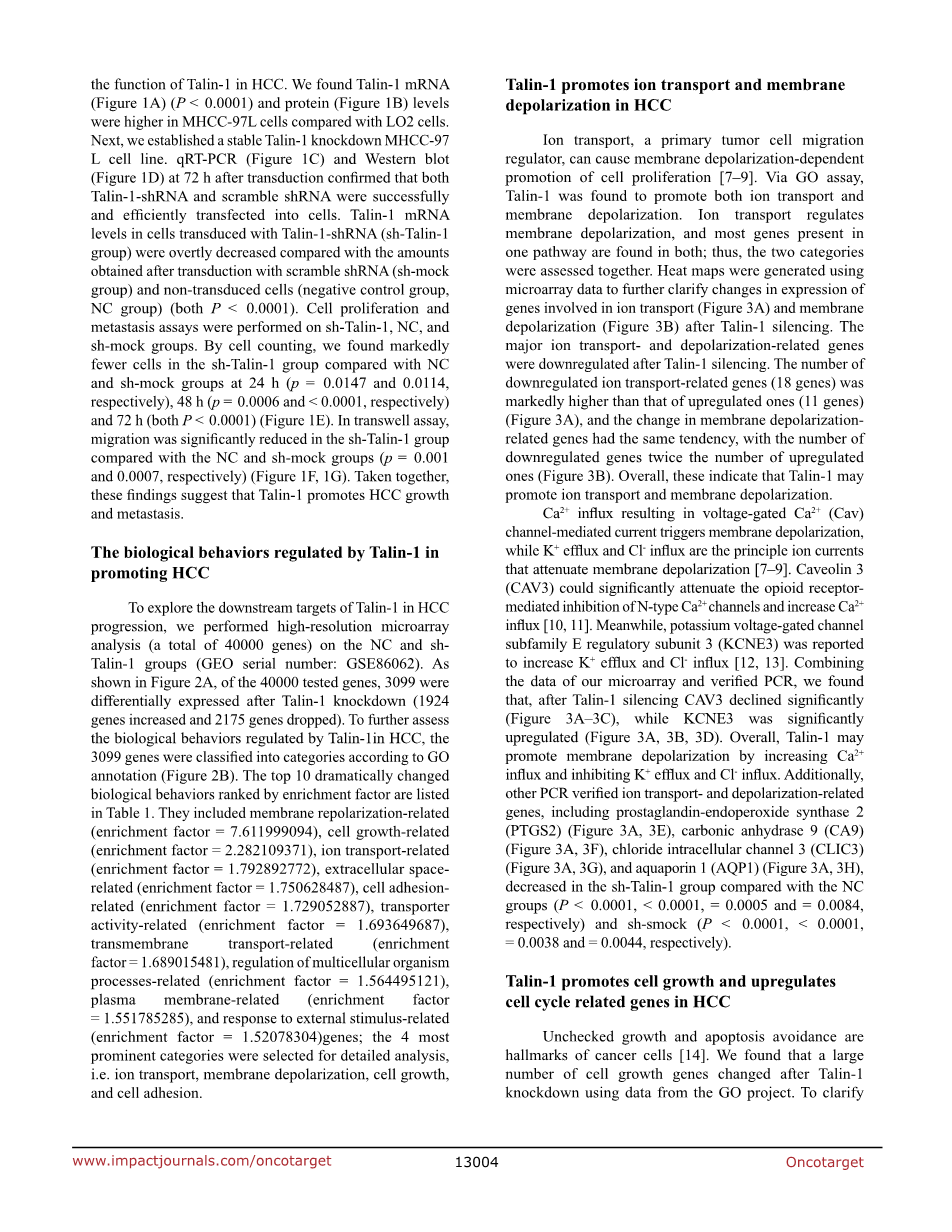

英语原文共 12 页,剩余内容已隐藏,支付完成后下载完整资料
Talin-1 interaction network and its role in liver disease.
Abstract
Focal adhesions are multi-protein, integrin-containing complexes that are controlled by protein-protein interactions. Talin serves as a central protein that participates in the activation of integrins and connects them with the actin cytoskeleton. The unique structure of the talin rod domain allows it to be folded and unfolded in response to the mechanical stress, revealing various binding sites. Thus, conformation changes of the rod domain provide the possibility for the cell to convert mechanical signals into chemical through multiple signaling pathways. This review will discuss the binding partners of talin, their interaction, effect on the cellular processes, and their possible roles in diseases.
Keyword: Mechanotrasduction; Talin; DLC1; Vinculin; YAP; Liver disease
Contents
Abstract.......................................................................................................I1. Overview................................................................................................1 1.1 Talin structure overview.............................................................1 1.2 Talin role in mechanotransduction .............................................3 2. Talin interaction network.....................................................................4 2.1 Interaction with Rap1 and RIAM...............................................4 2.2 Interaction with PIP2,and PIPKIgamma;...............................................5 2.3 Kindlin and talin integrin activation...........................................5 2.4 Interaction with FAK and Paxillin..............................................6 2.5 Interaction with DLC1................................................................7 2.6 Interaction with vinculin.............................................................8 2.7 Influence on YAP/TAZ through vinculin...................................9 3. Talin role in liver disease......................................................................9
4. Conclusion............................................................................................10 Figures......................................................................................................11References................................................................................................13 Acknowledgements..................................................................................24
1. Overview
1.1 Talin structure overview The physical connection between cells and the extracellular matrix is based on the multi-component molecular complexes that are controlled by integrins. The transmembrane proteins are the core of these structures. Integrins are consist of ?- ?- heterodimers that are providing the connection between ECM through their large extracellular domains and intracellular actin cytoskeleton via adapter proteins such as talin [1] and vinculin [2-4]. Cells can sense the rigidity of the ECM through integrin adhesions, which is a significant factor in various processes such as repair, maintenance and formation of tissue [5,6]. Extracellular microenvironment can regulate cell growth, proliferation, and differentiation via mechanical signals that are transmitted through integrins which act as a hub between ECM and cellular actin. Talin-1 is the main activator of integrins it links the cytoplasmatic domain of integrin with the actin cytoskeleton to form a focal adhesion (FA). [7] Focal adhesions are the congregates of the intracellular proteins that are acting as tension-sensing anchoring points that bond cells to the extracellular microenvironment. [8, 9] In addition, FAs promote intracellular reorganization leading to dynamic changes in cell morphologies and function [8-10]. The mechanical signals of the cell microenvironment can regulate cell growth, proliferation, and differentiation, and integrins act as the hub between ECM and cellular actin. As the main activator of integrin, Talin-1 connects the cytoplasmic domain of integrin with the cytoskeleton of actin to form focal adhesion [7]. With the analysis of the structure of Talin-1 in recent years [11], researchers have discovered that the special mechanically sensitive structure of Talin-1 provides the possibility for proteins to convert mechanical signals into chemical signals. The active form of Talin is well-characterized, while its inhibited state is barely studied. The inhibition of talin is crucial to the proper cell function and development, and its disruption contributes greatly to the migration of metastatic cancer cells [12-14]. The overexpression of talin can affect the migration, invasion, and cell adhesion of cancer cells. In the inhibited state rod structure folds into 15 nm closed spherical conformation based on the charge interaction. The rod structure can sense mechanical force and regulate the assembly and maturation of the focal adhesion complex (FAC). R9 and R12 shield the binding sites of integrin and phosphatidylinositol-4,5-bisphosphate (PIP2) of the FERM structure. R3 is extremely sensitive to mechanical forces. As the “goalkeeper” of FAC, it is the first to unfold the folded four-helix bundle under the action of relatively low mechanical force (5 pN), and the compact structure of Talin-1 begins to collapse. The second messenger PIP2 prompt Talin-1 to bind integrin, and Talin-1 conformation further
剩余内容已隐藏,支付完成后下载完整资料
资料编号:[257192],资料为PDF文档或Word文档,PDF文档可免费转换为Word
您可能感兴趣的文章
- 下游产品是硫酸乙酰肝素2-0-磺基转移酶的有效抑制剂外文翻译资料
- 奥希替尼的耐药性不断发展的格局外文翻译资料
- 伪五山淫羊隆区域特异性鼠李糖基转移酶催化丙烯醇的3-阿霉素酰化 反应外文翻译资料
- 标记化合物和放射性药物杂志外文翻译资料
- 脂肪酶大规模分离水飞蓟宾非对映异构体外文翻译资料
- 钯催化萘胺与二芳基二硫化物和二硒醚的 C-H键裂解近选择性加成反应外文翻译资料
- 铜催化,定向基团辅助氟化芳烃和异芳烃碳氢键外文翻译资料
- Talin1通过局灶性粘附信号和失巢凋亡抵抗促进肿瘤侵袭和转移。外文翻译资料
- 杜氏肌营养不良综合征中的外显子跳跃外文翻译资料
- 来源于红树林内生菌稀有的细菌产caryolanes类代谢产物Bacaryolanes A−C外文翻译资料


